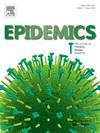缓慢进化的多宿主病原体的疫情重建:对三种现有牛分枝杆菌疫情爆发方法的比较研究
IF 2.4
3区 医学
Q2 INFECTIOUS DISEASES
引用次数: 0
摘要
在多宿主系统中,了解宿主物种对传播的贡献是适当确定控制和预防措施目标的关键。疫情重建方法旨在通过结合流行病学和基因数据来确定谁感染了谁,有助于实现这一目标。然而,这些方法中的大多数仍未在现实的多宿主模拟数据中得到验证。牛分枝杆菌是一种进化缓慢的多宿主病原体,以往对牛和野生动物疫情的研究发现了观察偏差。事实上,与牛相反,对野生动物进行采样非常困难。我们研究的目的是评估和比较现有的三种疫情重建方法(seqTrack、outbreaker2 和 TransPhylo)在模拟有偏差和无偏差的牛口蹄疫多宿主数据上的性能。我们扩展了现有的传播模型,模拟了 30 次涉及牛、獾和野猪的牛结核病爆发,并定义了六种模拟观察偏差的采样方案。我们估算了多宿主系统的一般和特定流行病学指标。我们测试了改变变异率或流行病学系统组成的四种替代传播方案。谁感染谁的重建对突变率很敏感,seqTrack 重建了多产的超级传播者。TransPhylo 和 outbreaker2 对每种宿主的贡献估计不足,无法重建流行病学中存在的死亡宿主。然而,seqTrack 和 outbreaker2 能正确地重建牛(而不是獾)指数病例的宿主物种。在考虑观察偏差时,这两个特定指标都有所改善。我们发现这三种方法在模拟有偏差和无偏差的 bTB 数据上的总体表现不佳。这似乎部分归因于牛海绵状芽孢杆菌的低进化率特征导致遗传信息不足,但也归因于模拟多宿主系统的复杂性。这项研究强调了综合方法的重要性,以及开发适应复杂流行病学系统的新疫情重建方法并在现实的多宿主数据上进行测试的必要性。本文章由计算机程序翻译,如有差异,请以英文原文为准。
Outbreak reconstruction with a slowly evolving multi-host pathogen: A comparative study of three existing methods on Mycobacterium bovis outbreaks
In a multi-host system, understanding host-species contribution to transmission is key to appropriately targeting control and preventive measures. Outbreak reconstruction methods aiming to identify who-infected-whom by combining epidemiological and genetic data could contribute to achieving this goal. However, the majority of these methods remain untested on realistic simulated multi-host data. Mycobacterium bovis is a slowly evolving multi-host pathogen and previous studies on outbreaks involving both cattle and wildlife have identified observation biases. Indeed, contrary to cattle, sampling wildlife is difficult. The aim of our study was to evaluate and compare the performances of three existing outbreak reconstruction methods (seqTrack, outbreaker2 and TransPhylo) on M. bovis multi-host data simulated with and without biases. Extending an existing transmission model, we simulated 30 bTB outbreaks involving cattle, badgers and wild boars and defined six sampling schemes mimicking observation biases. We estimated general and specific to multi-host systems epidemiological indicators. We tested four alternative transmission scenarios changing the mutation rate or the composition of the epidemiological system. The reconstruction of who-infected-whom was sensitive to the mutation rate and seqTrack reconstructed prolific super-spreaders. TransPhylo and outbreaker2 poorly estimated the contribution of each host-species and could not reconstruct the presence of a dead-end epidemiological host. However, the host-species of cattle (but not badger) index cases was correctly reconstructed by seqTrack and outbreaker2. These two specific indicators improved when considering an observation bias. We found an overall poor performance for the three methods on simulated biased and unbiased bTB data. This seemed partly attributable to the low evolutionary rate characteristic of M. bovis leading to insufficient genetic information, but also to the complexity of the simulated multi-host system. This study highlights the importance of an integrated approach and the need to develop new outbreak reconstruction methods adapted to complex epidemiological systems and tested on realistic multi-host data.
求助全文
通过发布文献求助,成功后即可免费获取论文全文。
去求助
来源期刊

Epidemics
INFECTIOUS DISEASES-
CiteScore
6.00
自引率
7.90%
发文量
92
审稿时长
140 days
期刊介绍:
Epidemics publishes papers on infectious disease dynamics in the broadest sense. Its scope covers both within-host dynamics of infectious agents and dynamics at the population level, particularly the interaction between the two. Areas of emphasis include: spread, transmission, persistence, implications and population dynamics of infectious diseases; population and public health as well as policy aspects of control and prevention; dynamics at the individual level; interaction with the environment, ecology and evolution of infectious diseases, as well as population genetics of infectious agents.
 求助内容:
求助内容: 应助结果提醒方式:
应助结果提醒方式:


